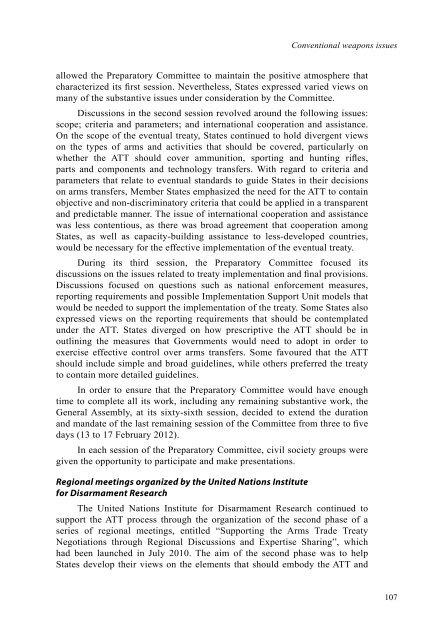DYB2011-Part-II-web
DYB2011-Part-II-web
DYB2011-Part-II-web
You also want an ePaper? Increase the reach of your titles
YUMPU automatically turns print PDFs into web optimized ePapers that Google loves.
Conventional weapons issues<br />
allowed the Preparatory Committee to maintain the positive atmosphere that<br />
characterized its first session. Nevertheless, States expressed varied views on<br />
many of the substantive issues under consideration by the Committee.<br />
Discussions in the second session revolved around the following issues:<br />
scope; criteria and parameters; and international cooperation and assistance.<br />
On the scope of the eventual treaty, States continued to hold divergent views<br />
on the types of arms and activities that should be covered, particularly on<br />
whether the ATT should cover ammunition, sporting and hunting rifles,<br />
parts and components and technology transfers. With regard to criteria and<br />
parameters that relate to eventual standards to guide States in their decisions<br />
on arms transfers, Member States emphasized the need for the ATT to contain<br />
objective and non-discriminatory criteria that could be applied in a transparent<br />
and predictable manner. The issue of international cooperation and assistance<br />
was less contentious, as there was broad agreement that cooperation among<br />
States, as well as capacity-building assistance to less-developed countries,<br />
would be necessary for the effective implementation of the eventual treaty.<br />
During its third session, the Preparatory Committee focused its<br />
discussions on the issues related to treaty implementation and final provisions.<br />
Discussions focused on questions such as national enforcement measures,<br />
reporting requirements and possible Implementation Support Unit models that<br />
would be needed to support the implementation of the treaty. Some States also<br />
expressed views on the reporting requirements that should be contemplated<br />
under the ATT. States diverged on how prescriptive the ATT should be in<br />
outlining the measures that Governments would need to adopt in order to<br />
exercise effective control over arms transfers. Some favoured that the ATT<br />
should include simple and broad guidelines, while others preferred the treaty<br />
to contain more detailed guidelines.<br />
In order to ensure that the Preparatory Committee would have enough<br />
time to complete all its work, including any remaining substantive work, the<br />
General Assembly, at its sixty-sixth session, decided to extend the duration<br />
and mandate of the last remaining session of the Committee from three to five<br />
days (13 to 17 February 2012).<br />
In each session of the Preparatory Committee, civil society groups were<br />
given the opportunity to participate and make presentations.<br />
Regional meetings organized by the United Nations Institute<br />
for Disarmament Research<br />
The United Nations Institute for Disarmament Research continued to<br />
support the ATT process through the organization of the second phase of a<br />
series of regional meetings, entitled “Supporting the Arms Trade Treaty<br />
Negotiations through Regional Discussions and Expertise Sharing”, which<br />
had been launched in July 2010. The aim of the second phase was to help<br />
States develop their views on the elements that should embody the ATT and<br />
107


